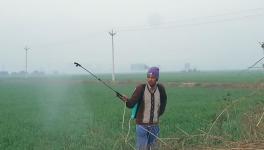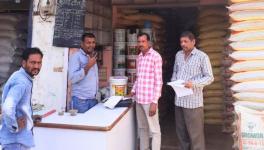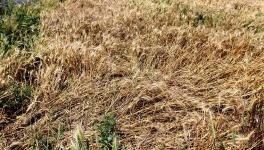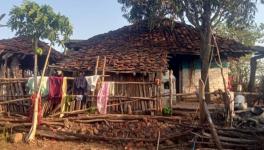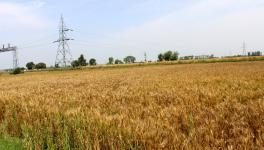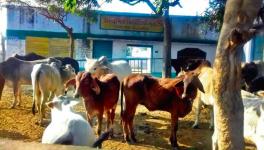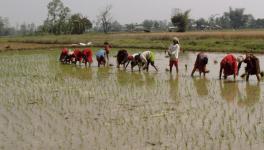Rajasthan: Fasal Bima Yojana and the Art of Minimising Payouts
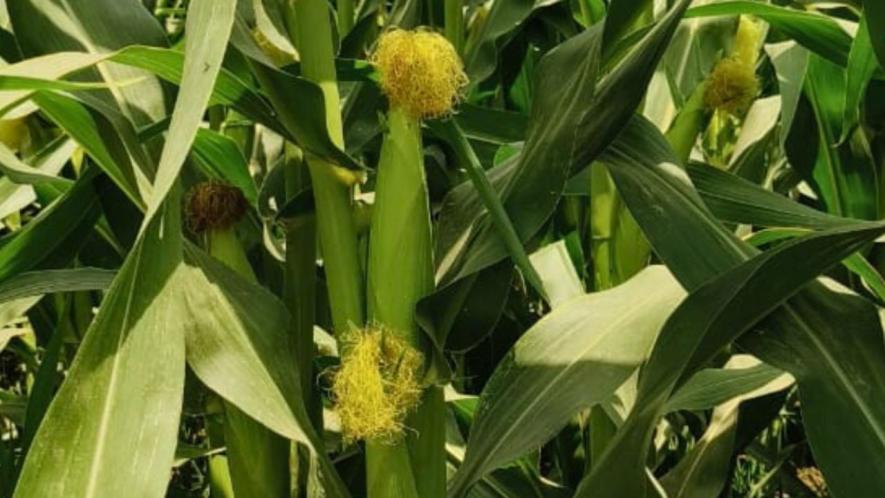
A healthy crop thriving in the field in Hanumangarh (Photo - Ashvi Jain, 101Reporters)
Hanumangarh, Rajasthan: “Despite submitting Aadhaar, Jan Aadhaar and all other necessary documents, the insurance company did not process my claim application under the Pradhan Mantri Fasal Bima Yojana [PMFBY]. They said I did not submit my Jan Aadhaar. When I argued against it, they asked me to show proof. From where am I supposed to show proof?” wondered Lal Chand, a farmer from Nohar in Rajasthan.
If farmers of Nohar and Bhadra in Hanumangarh district are to be believed, claim rejections have been the order of the day since 2021. According to them, the Agriculture Insurance Company (AIC) of India Limited, which implements PMFBY in the district, minimises insurance payouts, aided by the improper assessment of crop loss and other malpractices.
“The insurance company takes one-and-a-half years just to deny claims, when the expected timeframe is only two to three months... They give any reason for claim denial to one farmer, and then cancel the claim applications of the whole area based on the same reason,” said former Bhadra MLA Balwan Poonia.
Citing his experience, Nohar-based Bansi Jhakkar said AIC offered the claim amount only for 40% despite pests devouring his entire mustard crop in 2022. "They said it was the maximum allowed... Around 90% of the farmers here are unsatisfied with PMFBY. It is not planned or implemented well," he stated.
However, Vikram Kumar, field supervisor, AIC Nohar, told 101Reporters that the insurance company pays the claim amount as per the crop loss assessment made by the government employees.
In 2022-23, 88,333 out of the total 27,112,907 PMFBY claims received were rejected in Rajasthan. In Hanumangarh district, over 1,000 claims were rejected, many for minor reasons. Errors made during the insurance process, lack of proper documentation or failure to meet the specific requirements of the insurance company contribute to this.
Kumar said the most common reason for claim denial was when a farmer applied for the crop on land belonging to another person. "The land is of someone else, but insurance is taken by someone else cultivating that land. Insurance must be taken by the farmer who owns that land. Another common reason for denial is situations like a farmer having only 10 hectares insuring 20 hectares," he said.
"We conduct awareness campaigns to inform farmers about the dos and don'ts of insurance and guide them on when to fill out forms and the process for claims," added Kumar.
"The patwari examines whichever crop the farmer has mentioned during the insurance application. If the crop is different from what is stated in the claim document, the farmer's claim is denied. For crop insurance, the girdawari report of the revenue department is used to calculate the claim," said a revenue department staff on the condition of anonymity.
Crop cutting discrepancies
Rajasthan witnessed a massive loss in cotton crop recently. Farmers criticised the company of manipulating data to represent better yields in the area and justifying lowering/denial of claims. “Hanumangarh saw a huge loss of cotton crop last year, but no one received an appropriate claim amount,” sighed Lal Chand.
Bharatiya Kisan Union Nagaur district secretary Rampal Dhauliya said the problem relates to inaccuracies in sample weight during cotton crop-cutting experiments (CCEs), where the weight of the estimated yield of cotton in one sample is recorded as way less than the actual yield. “If a farmer sowed 10 quintals of cotton in one hectare but only received a yield of five quintals, he faced a loss. However, according to government documents, the estimated yield for one hectare of land is five quintals. This means the farmer will be denied the claim. The government should reconsider and adjust the estimated yield for cotton.”
CCEs are crucial for evaluating village and area yields. When a farmer files for an insurance claim, the PMFBY compares the insured yield with the estimated yield from CCEs to determine the insurance claim amount.
“Every patwari has to take four samples. Each unit consists of four samples taken from a randomly selected 4 m x 4 m area of the farm. Before the sampling, patwari determines the expected yield of that area. For instance, if someone planted cumin seeds, the patwari would have estimated the yield of a 4 m x 4 m area to be 2,000 grams. If the actual yield from that area turns out to be 1,000 grams, the farmer will be entitled to 50% of the claim. If a farmer's yield is the same as the estimated yield, no payout is possible,” explained Dhauliya.
Farmers are dissatisfied with the evaluation process as insurance companies deny claims based on non-representative samples. Sample collection should be more transparent. Lal Chand emphasised the variability in crop yields among farms in an area, arguing that the current system neglects individual assessments and fails to acknowledge these disparities. “The four samples collected set standards for the rest of the yield of the area. Yield of all farms in an area or a village is different. If any one farm gets infested, no one hears them,” he said.
Jhakkar also criticised the inefficiency in claim assessment, attributing it to superficial inspections by patwaris. However, Kumar said the government employees have to mail the insurance company two to three days prior to the field visit, so that the company employees can visit the location for CCE. "It is mandatory for the insurance company staff to be present during CCE."
“In one jurisdiction, for each crop, there should be a minimum of 16 samples for monitoring. PMFBY district nodal officer and the scheme director at the district level [in Hanumangarh, both are the same] should oversee the process, and one or two farmers should be present to ensure impartiality,” said Dhauliya, while adding that these requirements are not met.
“Generally, the patwari completes the work without any field visit and performs CCE from office. Officials started visiting fields for crop cutting only after farmer unions pressured the government,” he claimed.
“To accurately evaluate the yield of a particular area, a minimum of 16 samples are necessary. The primary workers involved have got only around one-and-a-half hours of training, which is inadequate considering their crucial role in handling the paperwork determining claim approval. It is important to ensure that these workers are well-trained to guarantee reliable and accurate output,” added Dhauliya.

Data on claims outstanding of all the states combines from 2016-17 to 2022 (Photo - Ashvi Jain, 101Reporters).
Satellite imagery new villain
In 2019, satellite imagery was introduced to reduce the time gap for settling farmers' claims. Satellite imagery assessed the crop area, crop condition and yield at the district level. This was to ensure transparency, accountability and timely payments of farmers' claims and to make the scheme more farmer-friendly.
“Satellite imagery provides coordinates from where crop cutting should be done. The satellite scans the entire village, and then the software randomly selects the sample unit for CCE. Both agriculture and revenue departments then test the sample,” Yogesh Verma, Joint Director Agriculture (Extension), Hanumangarh, told 101Reporters.
Farmers in Bhadra and Nohar are concerned about its accuracy and potential claim denials. It is evident that relying solely on satellite imagery has its shortcomings. The technology is misleading if not supplemented with a ground check.
“In 2022, mustard crop in Hanumangarh district was completely infested. Yet, the insurance company denied every claim by using satellite imagery that showed the area green and healthy,” said Lal Chand. “The colour of crops does not necessarily indicate their health, but insurance companies do not investigate these matters and rely solely on satellite imagery,” he added.
Kumar said AIC had nothing to do with satellite imagery and the claim calculation using it was done by the revenue department. Meanwhile, the revenue department staff advised farmers not to disturb the selected location for CCE and to assist primary workers during it for improved results."
The appeal process
If the claim rejections are not addressed properly at the block level, farmers can lodge their complaints with the District Level Grievance Redressal Committee (DGRC) presided over by the district magistrate/Collector. If any party at the district level disagrees with the judgment, they can bring their case before the State Level Grievance Redressal Committee (SGRC) within 15 days of the DGRC's ruling. The principal secretary/secretary of the Ministry of Agriculture and Farmers Welfare in charge of SGRC should resolve the issue within 15 days of receiving the grievance.
“If an insurance company declines a claim application for reasons such as incomplete documentation or no loss as per CCE data, a farmer can complain to the district Collector. The process takes almost a month, but farmers often get their claims,” explained Dhauliya.
“If a farmer is dissatisfied with the claim amount issued, they can appeal to the agriculture office. We will make every effort to resolve the issue. If either party is still not satisfied with the decision, the matter will be escalated to the district Collector’s office where a special committee will handle it. If the issue still remains unresolved, it will be taken to the state level,” said Verma.
(Ashvi Jain is a Rajasthan-based freelance journalist and a member of 101Reporters, a pan-India network of grassroots reporters.)
Get the latest reports & analysis with people's perspective on Protests, movements & deep analytical videos, discussions of the current affairs in your Telegram app. Subscribe to NewsClick's Telegram channel & get Real-Time updates on stories, as they get published on our website.









